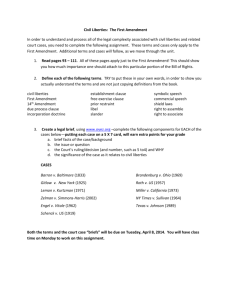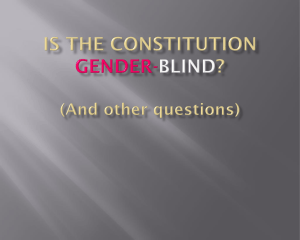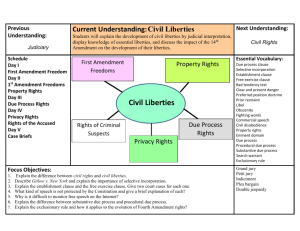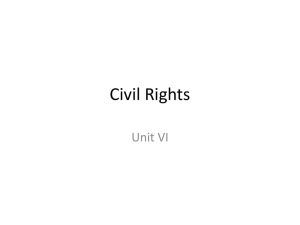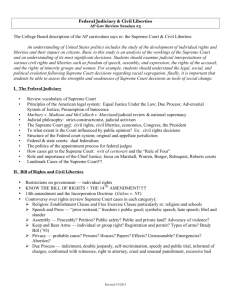Unit VIB: Civil Liberties and Civil Rights
advertisement
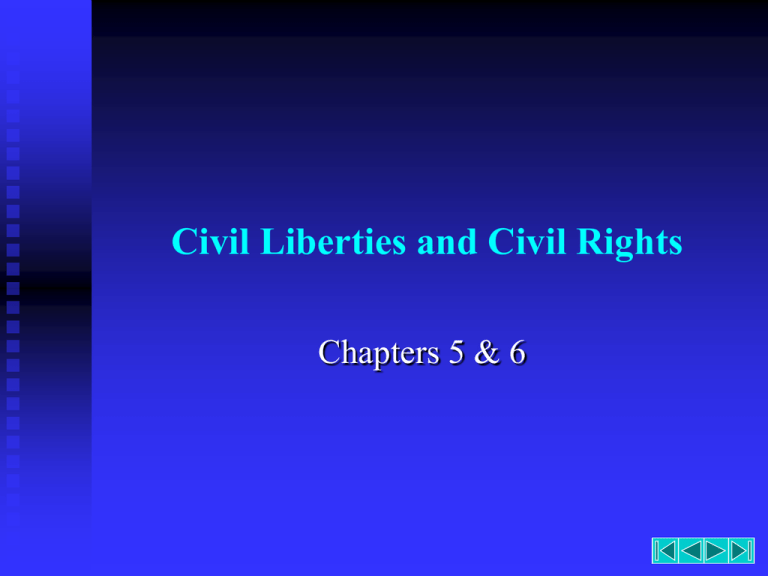
Civil Liberties and Civil Rights Chapters 5 & 6 Chpt. 15 Civil Liberties Key Terms to Know: Bill of Rights Civil liberties Clear-and-present danger doctrine Commercial speech Due-process clause Establishment clause Exclusionary rule Free-exercise clause Gitlow v. New York Incorporation doctrine Libel Mapp v. Ohio Miranda v. Arizona Patriot Act Obscenity Prior restraint Probable cause Search warrant Slander Symbolic speech Essential Questions to Answer: How do politics and culture affect civil liberties? How important is the first amendment? What is speech? Who is a person? Is there separation between church and state? What is due process? Civil Liberties versus Civil Rights civil liberties involve restraining the government’s action against individuals (only the government can violate your civil liberties) civil rights are rights all individuals share as provided for in the 14th amendment, which guarantees equal protection under the law (private individuals can violate these) Civil Liberties First Amendment of Bill of Rights religion, speech, press, assembly, petition Fourteenth Amendment due process clause incorporation—applying the Bill of Rights to the states incorporation began in 1897 most significant parts of Bill of Rights have been incorporated The Constitutional Basis for Our Civil Liberties Safeguards in the Original Constitution Guarantee of Habeas Corpus No bill of attainder No ex post facto law The Bill of Rights Function is to protect the rights of minority groups against the will of the majority. The Incorporation Issue Incorporating the Bill of Rights © 2004 Wadsworth Publishing / Thomson Learning™ 14th Amendment Due Process Clause- (also in 5th Amdmnt)—guarantees individuals a variety of rights from economic liberty to criminal procedural rights to protection from arbitrary or unjust laws) Incorporation doctrine—most limits on government contained in the Bill of Rights also apply to the states Equal Protection Clause—No state shall ... deny to any person within its jurisdiction the equal protection of the laws Freedom of Religion The Establishment Clause Prayer in the Schools- Engel v. Vitale (1962) (students cannot be forced to say a prayer written by the school board) Evolution versus Creationism- Epperson v. Arkansas (can’t prevent teaching evolution) Aid to Parochial Schools- Lemon v. Kurtzman (1971) (lemon test established- constitutional laws must 1) have a secular purpose 2) have a primary effect that neither advances nor prohibits religion, and 3) not foster excessive government entanglement with religion) What about posting the 10 Commandments? Student religious groups in schools? Student led prayer at high school football games? The Free Exercise Clause Belief and Practice are Distinct- Reynolds v. U.S. (government CAN limit acts that are illegal, even if done in the name of religion, such as bigamy, snake handling, and use of illegal drugs) Freedom of Expression permitted restrictions Speech that presents a “clear and present danger” Commercial speech Fighting words Slander Obscenity and pornography no prior restraint (government limits info before it is even published or communicated) protected speech symbolic speech (more protected--burning the flag, etc.) Seditious speech (advocating overthrow of govmnt) Seditious Speech Schenck v. United States, 1919 (distributing leaflets opposing the draft during war time was prohibited because it posed a “clear and present danger”) Gitlow v. New York, 1925 (14th amndmnt extends the 1st amndnt to states—state law made it a crime to advocate the duty, need, or appropriateness of overthrowing government by force or violence— Court said that the law was constitutional) Dennis v. United States, 1951 (speech in support of a violent overthrow of the U.S. government is not protected) Brandenburg v. Ohio, 1969 (government cannot punish inflammatory speech unless it is directed to inciting and likely to incite imminent lawless action—overruled Dennis) Freedom of the Press press has some protection from libel charges libel must be accompanied by actual malice the press is now protected from gag orders during trials, except in unusual circumstances radio and t.v. have much more limited 1st Amendment protections They are subject to the equal time rule Content regulation The Right to Assemble and Petition the Government protected by the 1st Amendment can be limited by municipalities’ right to offer permits for marches has been tested by anti-loitering ordinances aimed at reducing gangs from congregating Freedom of Assembly –must be a balance between the right of the people to express dissent and the responsibility of government to keep the peace Privacy Rights and Abortion no explicit right to privacy in Constitution Griswold v. Connecticut (1965) -- Supreme Court rules that privacy rights exist (Connecticut said contraceptives were illegal—court said there is a marital privacy right) comes from the 1st, 3rd, 4th, 5th and 9th Amendments Roe v. Wade (1973) court rules that privacy rights include abortion rights The Right to Privacy Do We Have the “Right to Die”? Washington v. Glucksberg (1997) (no right for a patient to seek suicide assistance from a doctor) Some states have passed suicide assistance laws (generally upheld by the Supreme Court) Homosexuality (Lawrence v. Texas, 2003) The Rights of the Accused The Rights of Criminal Defendants Fourth Amendment right against unreasonable search and seizure. Fifth Amendment right against double jeopardy. The Exclusionary Rule (out of 4th Amendment) Mapp v. Ohio (1961)- illegally obtained evidence is not admissible. The Miranda Warnings (1966) (out of 5th Amendment) Fifth Amendment right against self-incrimination. The Right to Counsel (6th Amendment) Gideon v. Wainwright (1963)- If accused of a felony, an attorney must be made available at the government’s expense. No Cruel and Unusual Punishment Clause (8th Amendment) Eighth Amendment also prohibits excessive bail and fines. States that Allow the Death Penalty © 2004 Wadsworth Publishing / Thomson Learning™ The Politics of Homeland Security Should We Carry National Identification Cards? Americans at Odds over Civil Liberties Should Hate Speech on Campus Be Banned? Is America One Nation “under God”? Should Americans Be More Concerned about the Erosion of Privacy Rights? Discussion Why is the Fourteenth Amendment so important to civil liberties? Should prayer be encouraged in public schools? Should religious accounts of the creation of life be given equal time with evolution? What are some important freedom-of-speech issues on campus? Have the courts done too much to protect the rights of the accused, or not enough? Chpt. 6 Civil Rights Key Terms to Know: Affirmative action Brown v. BOE Civil rights Civil Rights Act 1964 Civil rights movement De facto segregation De jure segregation 14th Amendment Freedom rights MLK, Jr. Montgomery bus boycott NAACP Nonviolent civil disobedience Plessy v. Ferguson Reasonableness standard Roe v. Wade Rosa Parks Separate-but-equal doctrine Sit-ins Strict scrutiny standard Swann v. CharlotteMecklenburg BOE Voting Rights Act 1965 Civil Rights History Constitution originally supported slavery 1857 Dred Scott 13th and 14th amendments Jim Crow laws 1896: separate but equal doctrine Civil Rights History (cont.) Segregation common in 20th century 1910: NAACP forms 1954: Brown v. Board of Education Civil rights movement Civil Rights Act of 1964 Voting Rights Act of 1965 Equal Rights Amendment not ratified Civil Rights all rights rooted in the Fourteenth Amendments’ guarantee of equal protection under the law what the government must do to ensure equal protection what the government must do to ensure freedom from discrimination Key Points of the Civil Rights Acts of 1865 to 1875 The First Civil Rights Act (1866) extended citizenship to anyone born in the United States gave African Americans full equality before the law authorized the president to enforce the act through use of force Key Points of the Civil Rights Acts of 1865 to 1875, (cont.) The Enforcement Act of 1870 set out specific penalties for interfering with the right to vote The Anti-Ku Klux Klan Act (1872) made it a federal crime to deprive an individual of his or her rights Key Points of the Civil Rights Acts of 1865 to 1875, (cont.) The Second Civil Rights Act (1875) everyone is entitled to equal enjoyment of public accommodation and places of public amusement imposed penalties for violators The Civil Rights Act were nullified through… The Civil Rights Cases (1883) th the Supreme Court rules that the 14 amendment only prevents official discriminatory acts by states, not by private individuals (this later changed) Plessy v. Ferguson (1896) stated that segregation did not violate the 14th amendment established the separate-but-equal doctrine provided constitutional justification for racial segregation, especially in the South Barriers to Voting by African Americans the white primary – a state primary election in which only whites may vote allowed because Southern politicians claimed political parties were private entities was outlawed by the Supreme Court in 1944 (Smith v. Allwright) grandfather clause – restricting voting to individuals who could prove that their grandfathers had voter prior to 1867 was used to exempt whites from poll taxes was used to exempt whites from literacy tests Barriers to voting by African Americans (cont.) poll taxes – required the payment of a fee to vote intended to disenfranchise poor African Americans was outlawed in national elections by the 24th amendment was outlawed in all elections by the Supreme Court in 1966 literacy tests -- required potential voters to read, recite or interpret complicated texts intended to disenfranchise African Americans Ending Legal Segregation Brown v. Board of Education of Topeka (1954) – Supreme Court rules public school segregation violates the 14th amendment overturns Plessy v. Ferguson Brown v. Board of Education (1955) – orders desegregation “with all deliberate speed” court–ordered busing: transporting African American children to white schools and white children to African American schools to end de facto segregation Court-ordered busing – transporting African American children to white schools and white children to African American schools Modern Civil Rights Legislation Civil Rights Act of 1964 forbade discrimination on the basis of race, color, religion, gender and national origin in voter registration public accommodations public schools expanded the power of the Civil Rights Commission withheld funds from programs administered in a discriminatory way established the right to equality of opportunity in employment (created the EEOC) Charges of Discrimination © 2004 Wadsworth Publishing / Thomson Learning™ The Civil Rights Movement Rosa Parks Montgomery, Alabama 1955 Martin Luther King, Jr. leads boycott King’s philosophy of nonviolence Civil rights activists emulate King’s use of Mahatma Ghandi’s tactics of civil disobedience Birmingham protest, 1963 March on Washington, 1963 “I Have a Dream” speech Black Power movement Malcolm X Modern Civil Rights Legislation, (cont.) Civil Rights Act of 1968 forbade discrimination in housing Voting Rights Act of 1965 outlawed discriminatory voter registration tests authorized federal registration and administration of voting where discrimination had taken place resulted in massive voter registration drives of African Americans in the South Women’s Struggle for Equal Rights Women’s Suffrage Movement was connected to the abolition movement suffragists organized the first women’s right convention at Seneca Falls, NY in 1848 established women’s suffrage associations finally won passage of the Nineteenth Amendment in 1920 Women’s Struggle for Equal Rights, (cont.) The Modern Women’s Movement spurred in by the publication of Betty Friedan’s The Feminine Mystique ( 1963) connected to the civil rights movement of the 1960’s argued for ratification of the Equal Rights Amendment failed to win the necessary states for ratification has targeted gender discrimination by challenging policies and laws in federal courts has advocated and encouraged an increasingly prominent role for women in government and politics “The right of citizens of the United States to vote shall not be denied or abridged by the United States or by any State on account of sex.” Gender-Based Discrimination in the Work Place gender discrimination – any practice, policy or procedure that denies equality of treatment to an individual or group because of gender prohibited by Title VII of the Civil Rights Act of 1964 applies even to “protective policies,” policies designed to protect women of child-bearing age Gender-Based Discrimination in the Work Place, (cont.) sexual harassment – unwanted physical or verbal conduct or abuse of a sexual nature that interferes with a recipient’s job performance OR creates a hostile environment OR carries and implicit or explicit threat of adverse employment consequences wage discrimination – women earn 76 cents for every $1.00 earned by men the glass ceiling – the phenomenon of women holding few of the top positions in professions or businesses Affirmative Action a policy in educational admissions or job hiring gives special consideration or compensatory treatment to traditionally disadvantaged groups is an effort to overcome present effects of past discrimination Bakke decision, 1978: reverse discrimination Supreme Court: “strict scrutiny” Special Protection for Older Americans Population Projections Attempts to Protect Older Americans Age Discrimination in Employment Act of 1967 – prohibits discrimination on the basis of age unless age is shown to be a bona fide occupational qualification Mandatory Retirement – is prohibited in most occupations by an amendment to the ADEA (1978) More and more old people © 2004 Wadsworth Publishing / Thomson Learning™ Securing Rights for Persons with Disabilities The Americans with Disabilities Act of 1990 requires all public buildings and services be accessible to persons with disabilities requires employers make reasonable accommodations for people with disabilities defines “disabilities” as physical or mental impairments that substantially limit everyday activities Supreme Court ruled that an HIV infection falls under the protection of the ADA conditions that can be medically corrected (medication, glasses) do not fall under ADA The Rights and Status of Gay Males and Lesbians in decades past, most states had anti-sodomy laws the Supreme Court upheld a law in Bowers v. Hardwick (1986) that made homosexual conduct between two adults a crime (but see Lawrence v. Texas) in Romer v. Evans (1996) the Supreme Court ruled that a Colorado amendment that invalidated state laws protecting homosexuals violated the equal protection clause now 12 states and 165 municipalities have laws that protect gay men and lesbians from discrimination The Rights and Status of Juveniles parents are viewed as protectors of children’s rights the 26th amendment grants 18-21 year olds the right to vote most contracts entered into by minors cannot be enforced parents can be held liable for minor’s negligent actions minors are sometimes viewed as incapable of criminal intent when minors are tried as adults, they are afforded the same protections, but are subject to adult penalties (including the death penalty) The Politics of Homeland Security Racial Profiling in the War on Terrorism Discussion In what circumstances is bilingual education warranted? What still needs to be done in the area of civil rights? Should gays and lesbians have the same rights as heterosexuals? Should affirmative action be extended? Abolished? What policies are necessary to promote gender equality? Essential Questions we Should Have Answered by Now: What was the “Black Predicament”? How do the courts influence civil rights? How does Congress influence civil rights? What is the stance for women and equal rights? What is affirmative action? Lets Tackle These: 1. Should numerical goals ever be used to ensure that students and workers are drawn from every racial group? 2. To what extent should the government be able to limit the opportunity to have an abortion? Key Concepts to Remember: 1. 2. The Bill of Rights was added to the Constitution to protect individual rights from encroachment by the federal government. Since the 1920’s, the 14th Amendment’s Due Process clause has been interpreted to include most of the protections guaranteed in the Bill of Rights and to prevent states from infringing on those rights. This is known as the Incorporation Doctrine and the process is called “selective incorporation.” Key Concepts to Remember: 3. The rights conferred by the Constitution are not absolute, and the extent of protection afforded by the Constitution has varied over time depending on a variety of political conditions, including the composition of the Supreme Court. It is the S.C. that plays the major role, but not the only one, in guaranteeing individual rights and liberties. Ultimately, the nature of the rights and liberties enjoyed by Americans is determined through the political process. Key Concepts to Remember: 4. Civil liberties are legal and constitutional protections against the government. Civil rights are policies that extend basic rights to groups historically subject to discrimination. 5. Americans have never fully come to terms with the concept of equality and the Equal Protection clause of the 14th Amendment. With the abandonment of the “separate but equal” doctrine in 1954 and the rise of the civil rights and women’s movements, the federal government has leaned toward policies aimed at tearing down the barriers represented by racial and other forms of discrimination. These policies, however, continue to stir major controversies within society as illustrated by the ongoing debate over affirmative action programs.

